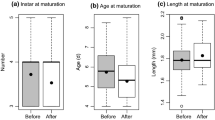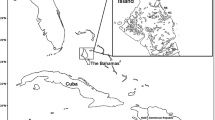Summary
In studying the relevance of the predation hypothesis as an explanation for the vertical migration of zooplankton two predictions were tested:
-
1)
The egg sacs of Eurytemora are sufficient to cause different predation pressure in food selection experiments with visually hunting planktivores as predators and ovigerous vs. non-ovigerous Eurytemora females as prey.
-
2)
If copepods avoid predation by vertical migration, there should occur differences in the vertical distribution pattern of ovigerous and non-ovigerous females according to selective predation.
The results showed that, when ovigerous and non-ovigerous females were presented to predators, a significant preference for ovigerous females was found in high densities of prey. No preference was found in experiments with males vs. non-ovigerous females and at low copepod densities. In a field study we found that non-ovigerous females distributed throughout the water column preferred the deeper parts. Ovigerous females were also abundant in deeper waters but almost totally avoided the surface layer above 20 m. Thus our results support the predation hypothesis when the adaptive value of vertical migration is considered.
On the basis of our results we deduced testable predictions on the evolutionary effects of predation:
-
1)
In heavily foraged communities there is strong coevolution among the prey to resemble each other in terms of which are critical in selective predation.
-
2)
If the carrying of an egg sac is considered as parental care, it is likely that parental care occurs more seldom in environments with high predation.
Similar content being viewed by others
References
Burkill PH, Kendall TF (1982) Production of the Copepod Eurytemora affinis in the Bristol Channel. Mar Ecol Prog Ser 7:21–31
Hudd R (1982) Feeding of Baltic herring larvae (Clupea harengus L.) in the Gulf of Finland. Finnish Fish Res 4:27–34
Hutchinson GE (1967) A Treatise on Limnology. John Wiley & Sons, New York
Iwasa J (1982) Vertical migration of zooplankton: a game between predator and prey. Am Nat 120(2):171–180
Lemmetyinen R, Mankki J (1975) The three-spined stickleback (Gasterosteus aculeatus) in the food chains of the northern Baltic. Merentutkimuslait Julk/Havsforskningsinst Skr 239:155–161
Lynch M (1980) The evolution of Cladoceran life histories. Quart Rev Biol 55:23–42
Ojaveer E, Simm M (1975) Effect of zooplankton abundance and temperature on time and place of reproduction of Baltic herring groups. Merentutkimuslait Julk/Havsforskningsinst Skr 239:139–145
Sandström O (1980) Selective feeding by Baltic herring. Hydrobiologia 69(3):199–207
Siegel S (1956) Nonparametric statistics for the behavioral sciences. Tokyo
Sjöblom V, Parmanne R (1978) The vertical distribution of Baltic herring larvae (Clupea harengus L.) in the Gulf of Finland. Finnish Fish Res 2:5–18
Stich H-B, Lampert W (1981) Predator evasion as an explanation of diurnal vertical migration by zooplankton. Nature 293:396–398
Wright W, O'Brien WJ, Vinyard G (1980) Adaptive value of Vertical migration: A Simulation Model Argument for the Predation Hypothesis. In: WC Kerfoot (ed), Evolution and ecology of zooplankton communities. University Press of New England, Hanover, New Hampshire 138–147
Vuorinen I (1981) Ympäristotekijöiden vaikutuksista eläinplanktonyhteisön rakenteeseen ja toimintaan Turun edustan merialueella. Lounais-Suomen vesiensuojeluyhd Julk 48:95–136
Vuorinen I (1982) The effect of temperature on the rates of development of Eurytemora hirundoides (Nordqvist) in laboratory culture. Ann Zool Fenn 19:129–134
Vuorinen I, Rajasilta M (1980) Kalanpoikasten ravinnosta rehevöityneellã merialueella. Suomen Kalastuslehti 87(7):204–207
Zaret T (1980) Predation and Freshwater Communities. Yale University Press, New Haven and London
Author information
Authors and Affiliations
Rights and permissions
About this article
Cite this article
Vuorinen, I., Rajasilta, M. & Salo, J. Selective predation and habitat shift in a copepod species — support for the predation hypothesis. Oecologia 59, 62–64 (1983). https://doi.org/10.1007/BF00388073
Received:
Published:
Issue Date:
DOI: https://doi.org/10.1007/BF00388073




